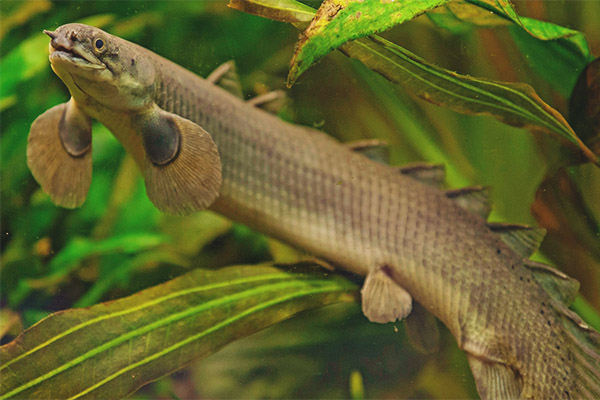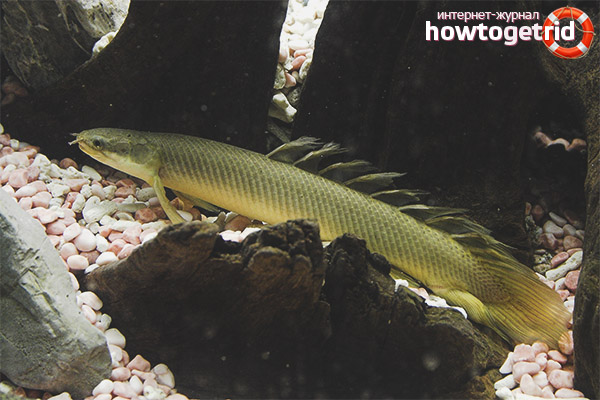The content of the article
According to research, the multi-pans came to this world even more than sixty million years ago. Modern polypteruses originated from the African continent. This species is divided into two subspecies. The first is Erpetoichthys, which has only one subspecies. And the second is known as Kalamoiht Kalabarsky or fish - a snake, it is he who has more than 12 different subspecies.
Polypterus, or in a different way, polypere, got its name due to multiple individual dorsal fins. In addition, they have a serpentine body with large pectoral fins, which they use to move and swim in a special way. They can dramatically accelerate with their own tail.
Polyperus has characteristics that are inherent in other prehistoric fish.These include the presence of pronounced nostrils, as well as large hard scales that protect them from the cruelty of the outside world. In addition, they produced for themselves modified swim bladders that resemble lungs and are divided into 2 parts horizontally. This feature allows representatives of this breed of fish to capture some air above the water, which is especially important if there is a low oxygen content in the pond.
Existence with other inhabitants of the aquarium
Modern aquaria divides these fish into several species, among them there are common and not very. In total, there are about 12. The most vivid, with a pronounced pattern, is a representative of the polypterus - ornatipinis or marble dragon. Degelsi - striped bishers have a body of extraordinary shape and size, which is suitable for medium aquariums. Their characteristic features are a pointed tail fin and the presence of dark blurry stripes against the background of a light body. Less popular types are Nile palm, endlicher and Senegalese.
The maintenance of polypherus in an aquarium is not particularly difficult with a certain experience of this occupation. Unwanted neighbors for them - fish with a large size and aggressive disposition - snakeheads and cichlids. They get along well with a fish - a knife, hital ornat, with a black knife, large barbs, catfish, and a voile synodontis. Soma with a mouth in the form of suckers will not be suitable for the neighborhood. With their attempts to suck, they will pester the polyterus. A great option to keep them with non-aggressive fish that are large in size. However, sometimes polypurus can attack larger fish and at the same time injure them, and all because he does not see well.
Polypterus always react to the presence of food in the aquarium, swimming out of the shelter. They move towards the stern until they are right next to it. Sometimes, because of poor eyesight, they have difficulty finding food and begin to search for it randomly.
Sometimes aquarists say that polypterus are common predators, but the statement is wrong, they are just omnivorous. Naturally, polypteruses eat smaller fish when present.They are fed with a variety of high protein foods, mussels, beef hearts, shrimps, fry and small fish. You can give them small pills, and even flakes. Juveniles feed on live food and sinking granulated.
Stereotypically, due to their slow movements and poor eyesight, there is an assumption that fish of this breed do not have the opportunity to catch prey in the form of fish living in water. But polypteruses are extremely active when needed. The biggest danger lurks other inhabitants of the aquarium at night, when they are hiding on the bottom, resting, and the polyterus is just showing activity.
Conditions of detention
To equip an aquarium for polypterus living, it is necessary to proceed from the size of its inhabitants, who are planned to be settled there. Even representatives of small species sometimes grow to about 30 cm in size in an aquarium, some individuals can reach about half a meter.
Much more important is the size of the width of the aquarium than its height. If the fish are small, then aquariums will fit, having an area from 1 meter to 20 cm by 40 cm.But, if its inhabitants are larger, then a larger reservoir with sizes from 180 to 60 cm will be needed. For polypterus, it is important to have atmospheric oxygen, to which they rise to the surface. Therefore, aquariums, which contains polyterus, must be closed so that there remains a layer of oxygen between the panes and water.
Particular care should be taken to ensure that the polypterus was not possible to make an escape from the reservoir. Some individuals tend to jump to the surface, and they may die. Most often, representatives of this breed of fish are described by aquarists as individuals, which in some places show aggressiveness among themselves and to other species. It happens that they start fights with representatives of their own species, most often this happens when fighting for food. But, fortunately, they are not able to cause significant harm to their relatives. If there is fish of the same size in the same tank, then there will hardly be any serious fights between them. Naturally, individual representatives may experience strong aggression, for this reason such individuals should be resettled.
Ground Requirements
The soil in an aquarium that contains a polyterus should be one that does not cause problems with cleaning and care. The best option is to have a thin layer of sand or small gravel on the bottom. But sand is more comfortable for them.
Decor
A large number of aquarists are of the opinion that polypteruses should be kept in empty aquariums. This makes it possible to reduce their territorial aggressiveness. However, an empty tank without decorative elements looks a bit dull. Moreover, polypteruses and look much more interesting if they are between plants, stones and shelters. For decorating the aquarium, it is preferable to use ceramic or plastic tubes, but their appearance is less natural.
Regarding plants: they are needed only for decoration, since polypteruses do not feed on them, but can be entertained with their help, making their way through dense thickets. For this reason, it is preferable to use hardwood species or moss as vegetation.
Filters
It is important to ensure a sufficient level of filtering.Although polypteruses are not the most mobile fish, moreover, they are quite clean, the use of protein feed for them can cause a lot of small waste, due to which water deteriorates quickly. Therefore, high-quality filtering is a must.
The temperature of the water for keeping these fish should be within 25 - 30 degrees. As for the parameters, they are not so important, but the water should be soft, the pH should be neutral or slightly acidic. The presence of light does not play a particularly important role for the reason that a polyterus is a night fish.
Possible diseases
This breed of fish has fairly good health. Due to their robust scales, the risk of various types of damage is minimal. For the same reason, they are little susceptible to bacterial infections and parasitic diseases. However, representatives of the breed that have fallen into aquariums from natural conditions may be contaminated by freshwater leeches. If you have any, you shouldn’t settle them with artificially bred fish.
Gender Differences
The distinction between males and females is somewhat difficult. The characteristic features of males are the presence of a wider, thick fin from the side of the tail, as well as the dorsal fin. Females are large compared to males. In young representatives of this breed of fish it is extremely difficult to determine the sex.
Breeding characteristics

It is worth noting that in captivity, they very rarely breed. All representatives of this breed of fish that fall on the implementation, as a rule, are caught in natural conditions. The condition for reproduction is slightly increased acidity of water. Sometimes provoke individuals to continue the kind by changing the parameters of water, its temperature and alkalinity.
How does this happen?
The males form cups from the caudal and anal fin, in which the females lay eggs. After that, they scatter them over small-leaved plants. After spawning, adults need to be resettled for the reason that they tend to eat their own eggs. Caviar looks quite large, it is about 3 mm in diameter. Larvae appear after about 4 days, no more. They begin to eat after 7 days.You can feed the fry with nautilias, artemia, and microworms.
Kinds
There are about a dozen different kinds of multi-pans. They are all very similar to each other. Some differ in size, color, place of origin. The most popular ones for content in an aquarium:
- Ornatipinis. The brightest and patterned appearance is polypherus ornatipinis, which is also called the marble dragon or variegated polypherus. His body has a gray-brown color. It is decorated with marble drawings. On the head of this fish there is a mesh pattern, and the belly has a yellowish-white color.
- Digelsi The digels polypterus or striped bisher also differ in average size. They have a pointed tail fin, and fuzzy black stripes are located along the light body. Its distinctive feature is a contrasting color. From abdomen to back color gradually acquires greater saturation from yellow to green.
- Senegalese. Senegalese, or gray polypterus, hails from Senegal and surrounding areas. They have a single color. Their original species is Senegalese albinos. Their scales have a marble-white color. The size of this type can be up to 40 centimeters.Silvery colors with a cool shade. The body is elongated, the scales are diamond-shaped.
Mnogoperov or polypterus appeared on planet Earth long before people came to it. These fish have a delightful prehistoric appearance, so they look very original and exotic. Their content does not cause any additional hassle. But still they should not be kept in the same tank with small fish. For some individuals, neighbors mnogoperov, this can end in a tragic way.
Despite the simplicity of the content, their breeding requires a particularly favorable conditions. The cost is about 1000 rubles.
Video: aquarium fish polyterus












To send